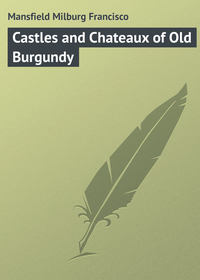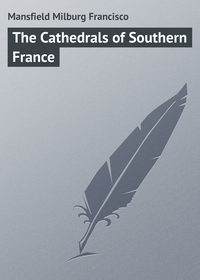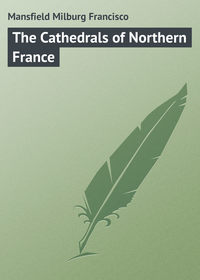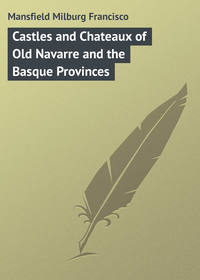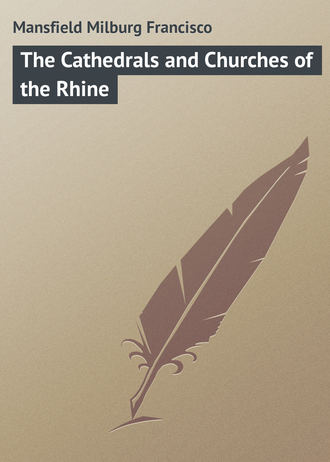 полная версия
полная версияThe Cathedrals and Churches of the Rhine
It would hardly be appropriate in a book such as this to attempt to trace the origin of Gothic, as we have come to know that twelfth and thirteenth century variety of pointed architecture, which, if anything, is French pointed. It has been plausibly claimed that, after its introduction into France and England, it developed into the full-blown style of the fourteenth century, which so soon fell before the Renaissance in the century following.
In Germany the process, with differences with regard to its chronology, was much the same.
It has been the fashion among writers of all weights of opinion to break into an apparently irresistible enthusiasm with regard to Gothic architecture in general, and this, so far as it goes, is excusable. Most of us will agree that "the folk of the middle ages had fallen in love with church-building, and loved that their goldsmith's work, and ivories, their seals, and even the pierced patterns of their shoes should be like little buildings, little tabernacles, little 'Paul's windows.' Some of their tombs and shrines must have been conceived as little fairy buildings; and doubtless they would have liked little angels to hop about them all alive and blow fairy trumpets."
In the building of the great cathedrals it must certainly be allowed that there is an element that we do not understand. Those who fashioned them worked wonder into them; they had the ability which children have to call up enchantment. "In these high vaults, and glistening windows, and peering figures, there was magic even to their makers."
Gothic art must ever, in a certain degree, be a mystery to us, because we cannot entirely put ourselves in the place of the men of those times. "We cannot by taking thought be Egyptian or Japanese, nor can we again be Romanesque or Gothic," nor indeed can we explain entirely the motif of Burmese architecture, which, appearing as a blend of Chinese and Indian, stands out as the exotic of the Eastern, as does the Gothic of the Western, world.
Only in these latter two species of architectural art does stone-carving stand out with that supreme excellence which does not admit of rivalry, though one be pagan and the other Christian.
Germany, above all other nations of the middle ages in Europe, excelled in the craftsmanship which fashioned warm, live emotions out of cold gray stone, and to-day such examples of this as the overpowering and splendid cathedrals at Cologne, Ratisbon, Strasburg, and Münster rank among the greatest and most famous in all the world, in spite of the fact that their constructive elements were reminiscent of other lands.
The distinction between French and German building cannot better be described than by quoting the following, the first by James Russell Lowell on Notre Dame de Chartres, and the second by Longfellow on the cathedral at Strasburg:
CHARTRES"Graceful, grotesque, with every new surprise of hazardous caprices sure to please, heavy as nightmare, airy, light as fun, imagination's very self in stone."
STRASBURG".. A great master of his craft,Ervin von Steinbach; but not he alone,For many generations laboured with him,Children that came to see these saints in stone,As day by day out of the blocks they rose,Grew old and died, and still the work went on,And on and on and is not yet completed."The first is typical of the ingenuity and genius of the French, the second of the painstaking labour of the Teuton; what more were needed to define the two?
"In Germany and throughout all the territory under the spell of Germanic influence the growth of Gothic was not so readily accomplished as in France," says Gonse.
"At best such Gothic as is to be seen at Bacharach, Bonn, Worms, etc., is but a variety, so far as the vaulting goes, of superimposed details on a more or less truthful Romanesque framework. At Mayence, Roermond, and Sinzig, too, it is the domical vault which still qualifies the other Gothic essentials, and so depreciates the value of the Gothic of the Rhine valley when compared with that of the Royal Domain of France."
The range of mediæval art and architecture has been said to run between the fourth century and the fourteenth, or from the peace of the Church to the coming of the Renaissance.
This is perhaps definite enough, but the scope is too wide to limit any special form of art expression, so that one may judge it comparatively with that which had gone before or was to come after.
Mostly, mediæval art groups itself around the two distinct styles of Byzantine and Gothic, and they are best divided, one from the other, by the two centuries lying between the tenth and the twelfth.
In truth, the architecture of Germany, up to the end of the tenth century, was as much Byzantine as it was Romanesque, and the princes and prelates alike drew the inspiration for their works from imported Italians and Greeks, a procedure which gave the unusual blend that developed the distinct Rhenish architecture.
The Popes themselves gave a very material aid when they sent or allowed colonies of southern craftsmen to undertake the work on these great religious edifices of the Rhine valley.
The grander plan of the cathedrals at Speyer, Worms, Mayence, Basel, and even Trèves are all due somewhat to this influence, and for that reason they retain even to-day evidences of these foreign and even Eastern methods, though for the most part it is in the crypt and subterranean foundations only that this is found.
Carlovingian architecture was perhaps more indigenous to Germany than to any other part of the vast Empire. "This extraordinary man," as the historians speak of Charlemagne, did much toward developing the arts.
In the southeast, the Grecian Empire was already become decrepit in its influences, and a new building spirit was bound to have sprung up elsewhere. "If Charlemagne," says Gibbon, "had fixed the seat of his empire in Italy, his genius would have aspired to restore, rather than violate the works of the Cæsars." He confined his predilections to the virgin forests of Germany, however, and he despoiled Lombardy to enrich his northern possessions; as witness the columns which he brought from Ravenna and Rome wherewith to decorate his palace and church at Aix-la-Chapelle.
No country has preserved finer or more numerous examples of Romanesque architecture than Germany. The Rhine was so powerfully under Roman sway that it adopted as a matter of course and without question quite all of the tenets and principles of the Romanesque; not only with respect to ecclesiastical structures, but as regards civil and military works as well.
On the Rhine, as in Lorraine, Lyonnaise, and Central France, the Romanesque endured with little deviation from Latin traditions till quite the end of the thirteenth century.
Later, in the Gothic period, Germany returned the compliment and sent Zamodia of Freiburg and Ulric of Ulm to lend their aid in the construction of the grand fabric at Milan; and John and Simon of Cologne to Spain to erect that astonishingly bizarre cathedral at Burgos.
Beginning with the revival of the arts in Italy, the Renaissance German architects, in other countries than Germany, were apparently few in number and not of their former rank.
Not alone did Italy aid Germany in the erection of ecclesiastical monuments, but France as well, with the Norman variation of the Romanesque and the later developed Gothic, sent many monkish craftsmen to lend their aid and skill. Their work, however, was rather the putting on of finishing touches than of planning the general outlines.
German architecture on the Rhine then was but a development and variation of alien importations, which came in time, to be sure, to be recognized as a special type, but which in reality resembled the Lombardic and the Romanesque in its round-arched forms, and the Gothic of France in its ogival details. German architecture in time, though not so much with respect to churches, even went so far as to imitate the rococo and bizarre ornamentation fathered and named by the Louis of France.
Germany was a stranger to the complete development of Gothic architecture long after it had reached its maturity elsewhere; so, too, it was quite well into the fifteenth century before the slightest change was made toward the interpolation of Renaissance details, and even then it was Renaissance art, more than it was Renaissance architecture, which was making itself felt.
The Renaissance came to Germany through the natural gateway of the north of Italy; although it spread perhaps to some extent from France into the Rhine district.
In truth, German Renaissance has ever been heavy and ugly, though undeniably imposing. In both the ecclesiastical and the secular varieties it lacked the lightness and grace which in France, so far as domestic architecture went, soon developed into a thing of surprising beauty.
What the Renaissance really accomplished in Germany toward developing a new or national style is in grave doubt, beyond having left a legacy of bizarre groupings and grotesque and superabundant ornament. In France the case was different, and, while in ecclesiastical edifices the result was poor and banal enough, there grew up the great and glorious style of the French Renaissance, which, for civic and private buildings of magnitude, has never been excelled by the modern architecture of any land.
In Germany proper, as well as in Switzerland, one finds house-fronts and walls covered with paintings, which is certainly one phase of Renaissance art. But the brush alone could not popularize the new style, and in religious edifices, at least, the Renaissance, as contrasted with the earlier Romanesque, never attained that popularity along the Rhine that it did in France or England, or even in Belgium.
Civic architecture took on the new style with a certain freedom, but religious architecture almost not at all. Possibly the "Thirty Years' War" (1618-48) had somewhat to do with stunting its growth; certainly no church-building was undertaken in those years, and they were the very ones in which, elsewhere, the Renaissance was making its greatest headway.
Another very apparent reason is that, as the major part of the population became Protestant, the need of a beautiful church edifice itself, as a stimulus to the faith, had grown less and less. There was a steady growth, perhaps one may as well say a great development, in civil architecture throughout Germany at this time, but, to all intents and purposes, from the early seventeenth century onward, the founding and erecting of great churches was at an end.
If one would study the Renaissance in Germany he must observe the town halls of such cities as Cologne, Paderborn, or Nuremberg, or the great châteaux or castles, such as are best represented by ruined Heidelberg.
Of religious architecture Renaissance examples are practically lacking; the most convincing details along the Rhine being seen in the western tower of the cathedral at Mayence.
At Hildesheim, at Nuremberg, and at Prague there are something more than mere "evidences" of the style, and throughout Germany, as elsewhere, there are many sixteenth and seventeenth century accessories, such as altars, baldaquins, tombs, and even entire chapels, which are nothing but Renaissance in motive and execution. But there are no great Renaissance ground-plans, façades, or clochers, which are in any way representative of the style which crept in to ring the death-knell of Gothic in France and England.
Perhaps it is for this reason alone that the great Gothic cathedral at Cologne was completed at a late day with no base Renaissance interpolation in its fabric.
V
THE ACCESSORIES OF GERMAN CHURCHES
Up to the tenth century the German basilicas were but copies of the Roman variety. Even the great cathedral at Trèves, with its ground-plan a great square of forty metres in extent, was but a gross imitation of the Romanesque form of the sixth century.
Later, in the eighth century, came the modified Byzantine form which one sees at Aix-la-Chapelle.
With the eleventh century appeared the double-apsed basilicas, but, from this time on, German ecclesiastical art divorced itself from Latin traditions, and from the simple parallelogram-like basilica developed the choir and transepts which were to remain for ever.
The crypt is a distinct and prominent feature of many German churches. On the Rhine curious and most interesting examples are very frequent, those at Bonn, Essen, München-Gladbach, Speyer, Cologne (St. Gérêon's), Boppart, and Neuss being the chief. All of these are so constructed that the level of the pavement is broken between the nave and choir, producing a singularly impressive interior effect.
Speyer has the longest, and perhaps the largest, crypt in all Germany.
Where the edifice has remained an adherent of Catholicism, the crypt often performs the function of a place of worship independent of the main church, it being fitted up with one or more altars and frequently other accessories.
As the crypt, instead of being only an occasional attribute, became general, squared, or even more rude, capitals replaced the antique and classical forms which Christian Italy herself had adopted from pagan Greece.
These squared or cubic capitals are particularly noticeable at Neuss, at München-Gladbach, in St. James at Cologne, and in the old abbey of Laach.
Towers came to be added to the west fronts, but the naves often remained roofed with visible woodwork, though, by the end of the century, the stone-vaulted nave had appeared in the Rhine district, and the pillars of pagan birth had given way to the columns and colonnettes of Latin growth.
What is known as the German manner of church-building had more than one distinguishing feature, though none more prominent than that of the columns of the nave and aisles. The naves were in general twice the width of their aisles, and the bays of the nave were made twice the width of those of the aisles. Hence it followed that every pier or column carried a shaft to the groin of the aisle vault, and every alternate one a shaft to the nave vault; and so grew the most distinct of all German features of Romanesque church-building, alternate light and heavy piers in the nave.
It is on the Rhine, too, that one comes upon occasional examples of rococo architectural decoration, a species which sounds as though it might originally have been Italian, but which was originally French. At its best it is seldom seen on the exterior, but on inside walls and porticoes, notably at Bruchsal on the Rhine, one sees a frankly theatrical arrangement of ornate details.
By the twelfth century the particular variety of Romanesque architecture which had developed, and still endures, in the Rhine valley had arrived at its maturity.
The thirteenth century saw the interpolation and admixture of Gothic, which elsewhere, in France in particular, was making such great strides.
Towers multiplied and became lighter and more graceful, and great Gothic arched windows gave place to round-headed ones, though scarcely ever to the entire exclusion of the latter variety.
The species of cross-bred style which forms the link between the Romanesque and Gothic abounds along the Rhine, and examples are frequently encountered.
The semicircular apsides, with a decorative band beneath the cornices of the exterior galleries, are also a distinctly Rhenish detail. They are to be seen in St. Peter's at Bacharach, at St. Castor's at Coblenz, St. Martin's at Cologne, the cathedral at Bonn, in St. Quirinus at Neuss, and again at Limburg.
The Rhenish bell-towers are a variety distinct from the towers and spires usually met with, and often terminate suddenly, as if they were unfinished.
Finally, there are a number of churches in this region which offer the singular, though not unique, disposition of a chevet showing a triple apsis. Notable examples of this style are St. Maria in Capitola, St. Andrew and St. Martin at Cologne, and St. Quirinus at Neuss.
The churches of the Rhine valley are abundantly supplied with steeples, often in groups far in excess of symmetry or sense, as for instance the outré group at Mayence, which is really quite indescribable.
The Apostles' Church at Cologne, the cathedrals at Mayence, Speyer, and Worms, and the abbey church of Laach all have wonderfully broken sky-lines; while those with great central towers, such as at Neuss, or the parish church of Sinzig, form another class; and the slim-spired churches at Andernach and Coblenz yet another. St. Martin's at Cologne is another single-spired church, but it rises from its three apses in quite a different manner from that of St. Quirinus at Neuss, and must be considered in a class by itself.
The minster at Bonn, though having three steeples, is not overspired, like that of Mayence, – indeed, it is perhaps one of the most picturesque, if somewhat theatrical, of all the spired churches of the Rhine, excepting always Limburg. The openwork spire of Freiburg is unequalled in grace by even that of Strasburg, whatever may be the actual value of its constructive details.
A marked type of German church architecture is that species of building known as the Hallenkirche. The variety is found elsewhere, even in France, but still it is distinctively German in its inception.
Usually they are of the triple-naved variety, i. e., a nave with its flanking aisles, with the aisles nearly always of the same height as the principal nave.
There are two great churches of this order – though lacking aisles – in France, the cathedrals at Rodez and Albi in the south.
Mostly these great halled churches exist in Westphalia, where there is a fine example in the cathedral at Paderborn, and again there is St. Ludger at Münster, and many others. In one form or another the type is frequently met with throughout Germany, and is therefore to be considered as a distinct German architectural expression.
In summing up, then, one may well conclude that German church architecture, in its general plan and outline, is not of the amazing beauty of the French, and is in a way lacking in mass effect. With respect to details and accessories, however, the German churches are graced with much that one would gladly find everywhere as an expression of the artistic embellishment of a great religious edifice.
In spite of the austerity of many of these German churches in the fabric itself, there is frequently an abounding wealth of accessory detail in fitments and furnishings.
In France the Revolution made away with much decorative embellishment and furniture of all sorts. The Reformation in Germany played no such part, and so there is left much really artistic detail which contributes a luxuriance that is wanting in constructive details.
The universally elaborate carven pulpits and choir-stalls are wonders of their kind. It is true they are usually of wood instead of stone, but it must be remembered that the Germans were ever great wood-workers.
The pulpits of Freiburg and Strasburg are thoroughly representative of the best work of this kind. They may be said, moreover, to be of the Gothic species only, whereas similar works elsewhere are most frequently of the Renaissance period.
In no other European country are the altars so rich in detail, the sacristies so full to overflowing with jewelled and precious metal cups, vases, and chalices, or the crucifixes, triptychs, and candlesticks so sumptuous.
In the cathedral at Aix-la-Chapelle the congregation seats itself upon chairs; but most frequently in Germany one finds sturdy, though movable, oaken benches.
Of the carved choir-stalls, those at St. Gérêon's at Cologne are the most nearly perfect of their kind on the Rhine; those at Mayence, while elaborately produced, being of a classic order which is manifestly pagan and out of keeping in a Christian church.
German churches in general made much of the cloister, though not all of the examples that formerly existed have come down to us undisturbed or even in fragmentary condition. But, in spite of the Protestant succession to many of the noble minsters, many of these cloisters have endured in a fair state of preservation. Attached to the western end of St. Maria in Capitola at Cologne is an admirable example, while the Romanesque types at Bonn, at the abbey of Laach, and at Essen are truly beautiful. Examples of the later pure Gothic construction are those at Aix-la-Chapelle and Trèves.
But little exterior sculpture has been preserved in all its originality in the Rhenish provinces, revolutionary fury and its aftermath having accounted for its disappearance or mutilation. In the Cistercian church at the abbey of Altenburg, there is a plentiful display of foliaged ornament, and there are the noble statues in the choir of the cathedral at Cologne. Mayence has a series of monuments to the bishop-nobles attached to the piers of the nave, and in the Liebfrau Kirche at Trèves and the cathedral at Strasburg are seen the best and most numerous features of this nature.
One of the most unusual of mediæval church furnishings, a sort of chandelier, is seen both at Aix-la-Chapelle and Hildesheim. In each instance it is a vast hoop-like pendant which bears the definition of coronæ lucis. Others are found elsewhere in Germany, but not of the great size of these two.
Organ-cases here as elsewhere are mostly abominations. The makers of sweet music evidently thought that any heavy baroque combination of wood-carving and leaden pipes was good enough so long as the flow of melody was uninterrupted.
The stained glass throughout the Rhine valley is mostly good and unusually abundant, and the freedom of this accessory from fanatical desecration is most apparent. The same is true of such paintings as are found hung in the churches, though seldom have they great names attached to them; at least, not so great as would mark them for distinction were they hung in any of the leading picture galleries of Europe.
At Essen the baptistery is separated from the main church, like that at Ravenna, or at Aix-en-Provence, the two foremost examples of their kind. A little to the westward of this minster, and joined to it by a Romanesque ligature, is a three-bayed Gothic church which occupies the site, or was built up from a former chapel dedicated to St. John the Baptist.
Sooner or later the custom became prevalent of erecting a baptismal font within the precincts of the main church itself, thus doing away with a structure especially devoted to the purpose. This change came in the ninth century, hence no separate baptisteries are found dating from a later epoch only, except as an avowed copy of the earlier custom.
At this time, too, immersion had given way to sprinkling merely, though in many cases the German name still applied is that of taufstein, meaning dipping-stone.
Late examples of fonts were frequently in metal, the most remarkable in the Rhine valley being in St. Reinhold's at Dortmund, in St. Maria in Capitola, and St. Peter's at Cologne, and in St. Mary's and St. James's at Mayence.
One of the most elaborate, and certainly the most beautiful and remarkable of all, is the stone font of the cathedral at Limburg.
VI
CONSTANCE AND SCHAFFHAUSEN
ConstanceThere is a sentimental interest attached to Constance and the lake which lies at its door, which has come down to us through the pictures of the painters and the verses of the poets. Aside from this, history has played its great part so vividly that one could not forget it if he would.
The city was founded about 297 A.D. In after years it fell before the warlike Huns, and all but disappeared, until it became the seat of a bishop in the sixth century, the jurisdiction of the bishopric extending for a dozen leagues in all directions.
In the tenth century it became a ville impériale, and by the fifteenth it had a population of more than forty thousand souls, and the bishopric counted eight hundred thousand adherents. To-day the city proper has decreased in numbers to a population which hovers closely about the five thousand mark.
The emperors convoked many Diets at Constance, and in 1183 the peace was signed here between the Emperor Barbarossa and the Lombard towns.
The cathedral, or münster, of Constance is dedicated to "Our Lady", and is for the most part a highly satisfying example of a Renaissance church, though here and there may be noticed the Gothic, which was erected on the eleventh-century foundations.




